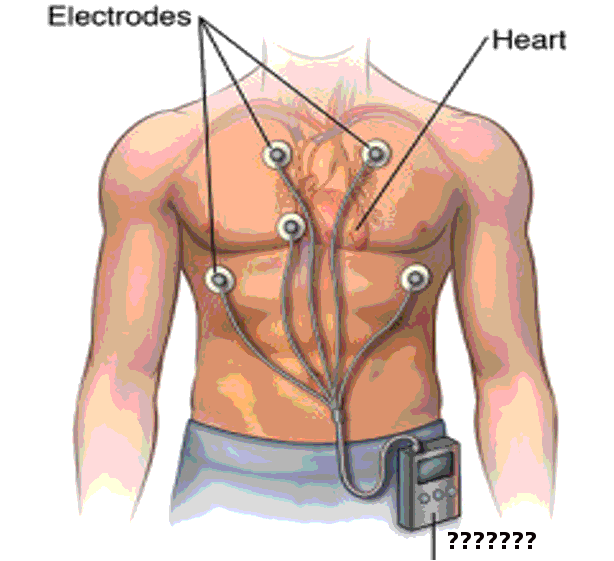[1]
HOLTER NJ, GENERELLI JA. Remote recording of physiological data by radio. Rocky Mountain medical journal. 1949 Sep:46(9):747-51
[PubMed PMID: 18137532]
[2]
Pevnick JM, Birkeland K, Zimmer R, Elad Y, Kedan I. Wearable technology for cardiology: An update and framework for the future. Trends in cardiovascular medicine. 2018 Feb:28(2):144-150. doi: 10.1016/j.tcm.2017.08.003. Epub 2017 Aug 9
[PubMed PMID: 28818431]
[3]
Giada F, Bartoletti A. Value of Ambulatory Electrocardiographic Monitoring in Syncope. Cardiology clinics. 2015 Aug:33(3):361-6. doi: 10.1016/j.ccl.2015.04.004. Epub
[PubMed PMID: 26115822]
[4]
Diemberger I, Gardini B, Martignani C, Ziacchi M, Corzani A, Biffi M, Boriani G. Holter ECG for pacemaker/defibrillator carriers: what is its role in the era of remote monitoring? Heart (British Cardiac Society). 2015 Aug:101(16):1272-8. doi: 10.1136/heartjnl-2015-307614. Epub 2015 May 22
[PubMed PMID: 26001846]
[5]
Wang R, Blackburn G, Desai M, Phelan D, Gillinov L, Houghtaling P, Gillinov M. Accuracy of Wrist-Worn Heart Rate Monitors. JAMA cardiology. 2017 Jan 1:2(1):104-106. doi: 10.1001/jamacardio.2016.3340. Epub
[PubMed PMID: 27732703]
[6]
Jakicic JM, Davis KK, Rogers RJ, King WC, Marcus MD, Helsel D, Rickman AD, Wahed AS, Belle SH. Effect of Wearable Technology Combined With a Lifestyle Intervention on Long-term Weight Loss: The IDEA Randomized Clinical Trial. JAMA. 2016 Sep 20:316(11):1161-1171. doi: 10.1001/jama.2016.12858. Epub
[PubMed PMID: 27654602]
Level 1 (high-level) evidence
[7]
Mâsse LC, Fuemmeler BF, Anderson CB, Matthews CE, Trost SG, Catellier DJ, Treuth M. Accelerometer data reduction: a comparison of four reduction algorithms on select outcome variables. Medicine and science in sports and exercise. 2005 Nov:37(11 Suppl):S544-54
[PubMed PMID: 16294117]
[8]
Prabhu S, Taylor AJ, Costello BT, Kaye DM, McLellan AJA, Voskoboinik A, Sugumar H, Lockwood SM, Stokes MB, Pathik B, Nalliah CJ, Wong GR, Azzopardi SM, Gutman SJ, Lee G, Layland J, Mariani JA, Ling LH, Kalman JM, Kistler PM. Catheter Ablation Versus Medical Rate Control in Atrial Fibrillation and Systolic Dysfunction: The CAMERA-MRI Study. Journal of the American College of Cardiology. 2017 Oct 17:70(16):1949-1961. doi: 10.1016/j.jacc.2017.08.041. Epub 2017 Aug 27
[PubMed PMID: 28855115]
[9]
Chai PR. Wearable Devices and Biosensing: Future Frontiers. Journal of medical toxicology : official journal of the American College of Medical Toxicology. 2016 Dec:12(4):332-334
[PubMed PMID: 27352082]
[10]
George L, Gargiulo GD, Lehmann T, Hamilton TJ. Concept Design for a 1-Lead Wearable/Implantable ECG Front-End: Power Management. Sensors (Basel, Switzerland). 2015 Nov 19:15(11):29297-315. doi: 10.3390/s151129297. Epub 2015 Nov 19
[PubMed PMID: 26610497]
[11]
Lobodzinski SS. ECG patch monitors for assessment of cardiac rhythm abnormalities. Progress in cardiovascular diseases. 2013 Sep-Oct:56(2):224-9. doi: 10.1016/j.pcad.2013.08.006. Epub
[PubMed PMID: 24215754]
[12]
Albers GW, Bernstein RA, Brachmann J, Camm J, Easton JD, Fromm P, Goto S, Granger CB, Hohnloser SH, Hylek E, Jaffer AK, Krieger DW, Passman R, Pines JM, Reed SD, Rothwell PM, Kowey PR. Heart Rhythm Monitoring Strategies for Cryptogenic Stroke: 2015 Diagnostics and Monitoring Stroke Focus Group Report. Journal of the American Heart Association. 2016 Mar 15:5(3):e002944. doi: 10.1161/JAHA.115.002944. Epub 2016 Mar 15
[PubMed PMID: 27068633]

